Geochemistry,zircon U–Pb geochronology,and Hf isotopes of S-type granite in the Baoshan block,constraints on the age and evolution of the Proto-Tethys
2024-03-06JianjunZhangChuanlongMouChendongLiuYongZhangTingChenHualiangLi
Jianjun Zhang • Chuanlong Mou • Chendong Liu • Yong Zhang •Ting Chen • Hualiang Li
Abstract Geochemistry,zircon U–Pb geochronology,and Hf isotope data for the Early Paleozoic granites in the Baoshan Block reveal the Early Paleozoic tectonic evolution of the Proto-Tethys.The samples are high-K,calcalkaline,strongly peraluminous rocks with A/CNK values of 1.37–1.46,are enriched in SiO2,K2O,and Rb,and are depleted in Nb,P,Ti,Eu,and heavy rare earth elements,which indicates the crystallization fractionation of the granitic magma.Zircon U–Pb dating indicates that they formed in ca.480 Ma.The Nansa granites have εHf(t) values ranging from -16.04 to 4.36 with corresponding TCDM ages of 2.10–0.81 Ga,which suggests the magmas derived from the partial melting of ancient metasedimentary with minor involvement of mantle-derived components.A synthesis of data for the Early Paleozoic igneous rocks in the Baoshan block and adjacent (Tengchong,Qiangtang,Sibumasu,Himalaya,etc.)blocks indicates that these blocks were all aligned along the proto-Tethyan margin of East Gondwana in the Early Paleozoic.The Early Paleozoic S-type granites from Nansa were generated in a high-temperature and low-pressure (HTLP) extensional tectonic setting,which resulted from Andean-type orogeny instead of the final assembly of Gondwana or crustal extension in a non-arc environment.In certain places,an expanding environment may exist in opposition to the tectonic backdrop of the lithosphere’s thickening and shortening,leading the crust to melt and decompress,mantle-derived materials to mix,and a small quantity of peraluminous granite to emerge.
Keywords Baoshan block ∙Early Paleozoic ∙Granite ∙Geochemistry ∙Zircon ∙Geochronology ∙Hf isotope
1 Introduction
The West Burma,Baoshan,and Tengchong terranes are located in the south of the eastern Tethys tectonic domain(ETTD),which is a large-scale orogenic zone that stretches between the Indian and Eurasian plates,while the Qiangtang and Lhasa terranes are located in the north (Fig.1a).As a result of several stages of oceanic subduction,plate convergence,collision,and accretion,the ETTD is covered with a substantial amount of igneous rocks (Wang et al.2013;Deng et al.2017).With the assembling of many continental pieces and the commencement of subduction along the Peri-Gondwana edge,the Late Neoproterozoic-Early Paleozoic period is noteworthy (Murphy et al.2011;Zhu et al.2012;Meinhold et al.2013).Yet,the later Cenozoic deformation brought on by the collision of India and Eurasia frequently makes it difficult to unravel the petrogenesis and tectonic backgrounds of these rocks (Pan et al.2012).Lately,numerous works argued that the Early Paleozoic magmatic rocks were formed by the final assembly of Gondwana (Xu et al.2014),however,the majority of studies stated that these were formed by Andean-type orogeny(Wang et al.2013).Even though past researchers have amassed a wealth of information,more research is required since the Early Paleozoic East Tethyan evolution model cannot be accurately and entirely constructed with the current understanding.To attempt to solve these issues,more support from geochemical,geochronological,and isotopic geological analyses of Early Paleozoic magmatic groups is necessary,as stated previously.We investigate the granites found in the Baoshan block and present new geochemical and geochronological data such as petrography,whole-rock geochemistry,zircon U–Pb ages,and zircon Hf isotopic data since the Baoshan block is an important branch of the ETTD.Through an investigation of the petrogenesis and tectonic settings of Early Paleozoic granites,the tectonic evolution of western Yunnan and its relationship with the Gondwana supercontinent are discussed.
2 Geological background and petrography
The Nujiang-Longling-Luxi fault to the west and the Kejie-Nandinghe fault to the east border the Baoshan block,which is located in the midst of the Tibet-Yunnan-Thailand-Malaysia plate (Fig.1b).The principal argument for relocating the Baoshan block to the northern boundary of Gondwana during the Cisuralian is the presence of diamictites and cool-water fossils with Gondwana affinities(Wopfner 1996;Metcalfe 2013).The Gongyanghe Group,the earliest sedimentary series in the Baoshan block,is formed of metamorphosed volcano-sedimentary rocks,tonalite,and gabbro with no Early Paleozoic deposits(Yang et al.2012).Late Precambrian,Early Paleozoic,Middle Permian,Late Triassic,and Cretaceous granites are the principal intermediate-felsic intrusions in the Baoshan block(Dong et al.2013b;Li et al.2015a).The majority of the Late Precambrian granitic rocks are exposed in the Laojiezi and Zhibenshan regions,with ages of 645 and 687 Ma,respectively (Zhang et al.1990;Li et al.2010a).The Early Paleozoic peraluminous granitoids,which largely occur in the Shuangmaidi and Pinghe districts,have been dated 502–448 and 468–447 Ma,respectively (Wang et al.2013;Li et al.2015a,2016a).The Muchang pluton(ca.266 Ma) represents the Middle Permian A-type granites that were emplaced in the south half of the Baoshan block (Ye et al.2010).The Late Triassic S-type granites(about 231 Ma) were deposited on the eastern margin of the Baoshan block (Nie et al.2012).The Zhibenshan pluton represents the Early Cretaceous S-type granites (ca.127 Ma).The Huataolin pluton represents Cenozoic granite (ca.100–60 Ma) (Jin and Zhuang 1988;Chen et al.2008).
The Pinghe batholith is the largest granitoid intrusion in the Baoshan block,comprising an estimated outcrop area of approximately 800 km2(Fig.1b).Granite and monzogranite are the primary lithologies of the Pinghe Batholith.The mineral content,structure,and structure of the rock are rather uniform.The lithology of the edge is somewhat transitional to neutral granodiorite,although no lithofacies zoning is seen.The Nansa pluton is an intrusion of the Pinghe batholith.According to a field study,the lithology of the Nansa pluton is leucogranite,which differs from the Pinghe batholiths (Fig.2a).They are made up of anhedral granular quartz (31%–43%),subhedral K-feldspar (23%–32%),subhedral and platy plagioclase (24%–34%),with mild sericitization in the center area,3%–8% muscovite,and 2%–3% biotite.Biotite is the most common ferromagnesian phase.Zircon,apatite,magnetite,and ilmenite are examples of accessory minerals (Fig.2b).
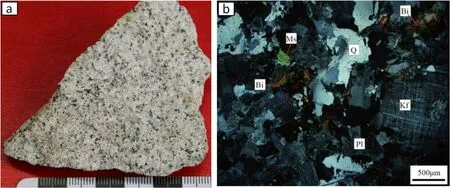
Fig.2 Outcrop and micrographic photos of representative granitic samples from the Nansa area in the Baoshan block,SW China.Q:quartz,Kf:K-feldspar,Pl: plagioclase,Ms: Muscovite,Bi: biotite
3 Analytical methods
3.1 Whole-rock major and trace elements
Before examination,bulk materials were crushed to 200 mesh using an agate mill.Major element oxides were evaluated using a wavelength X-ray fluorescence (XRF)spectrometer at the Research Center of Analyses,Beijing Research Institute of Uranium Geology,Beijing,China,with analytical errors of less than 5%.The gravimetric technique was used to calculate the LOI.In the Central Laboratory of Mineral Resources,Institute of Geology and Geophysics of the Chinese Academy of Sciences in Beijing,China,trace element compositions were determined using a Finnigan MAT Element mass spectrometer.Liu et al.(2008) describe the entire analytical technique.Indium was employed as an internal standard for matrix effects and instrument drift correction.Regular studies of standards with a 10% frequency were used to manage measurement error and drift.The uncertainties measured at the ppm level are less than 3%–10%for trace elements and 5%–10% for REE.
3.2 LA-ICP-MS zircon U–Pb dating
Zircon grains for U–Pb dating were purified by handpicking under a binocular microscope after being separated using conventional density and magnetic separation techniques.Zircons that had been separated were mounted in epoxy resin,polished to half their thickness,covered in gold,and captured in both transmitted and reflected light for photography.Before U–Pb isotopic analyses,each grain’s internal structure was analyzed using cathodoluminescence (CL) imaging via a scanning electron microprobe.
LA-ICP-MS was used to conduct U–Pb dating and trace element analyses of zircon at the key laboratory for the study of focused magmatism and giant ore deposits,the China Geological Survey Xi’an Geological Survey Center.A Geo Las Pro was used for laser sampling.Ion-signal intensities were measured using an Agilent 7700 × ICPMS instrument.As a carrier gas,helium was used.Argon was used as a make-up gas and was mixed with the carrier gas before entering the ICP via a T-connector.Each analysis included a 10-s background acquisition (gas blank)followed by a 40-s data acquisition from the sample.
Each individual analysis was collected using the Agilent Chemstation.Glitter 4.4 performed offline selection and integration of background and analyte signals,as well as time-drift correction and quantitative calibration for trace element analyses and U–Pb dating.The instrumentation and data acquisition procedures are similar to those described by Li et al.(2015a,b,c).
The external standard for U–Pb dating was Zircon 91,500.A linear interpolation was used to correct timedependent drifts in U-Th-Pb isotopic ratios with time.The uncertainty of preferred values for the external standard 91,500 was propagated to the sample results.Isoplot/Ex version 3 was used to create Concordia diagrams and weighted mean calculations (Ludwig 2003).Zircon trace element compositions were calibrated against reference materials(NIST610)and Si as internal standardization.The GeoReM database was used to determine the preferred element concentrations for the NIST reference glasses.
3.3 Hf isotope analyses
At the key laboratory for the study of focused magmatism and giant ore deposits,MLR,in the Xi’an Center of Geological Survey,China Geological Survey,in situ zircon Hf isotope analyses were performed using a Geolas Pro laserablation system coupled to a Neptune multiple-collector ICP-MS.The instrumentation and data acquisition procedures are similar to those described by Meng et al.(2014).For the analyses,a stationary laser ablation spot with a beam diameter of 30 μm was used.Helium was used to transport the ablated aerosol,which was then mixed with argon in a mixing chamber before being introduced to the ICP-MS plasma.All of the Hf analyses were performed at the same locations for U–Pb laser ablation.During this study,the reference standard was zircon GJ-1,which produced a weighted mean176Hf/177Hf ratio of 0.282030 (2 SE).
4 Results
4.1 Major and trace elements
The SiO2and Al2O3compositions of the samples are 69.80–71.15% and 15.98–16.83%,respectively (Table 1),which is consistent with the Pinghe plutonic batholith (Liu et al.2009;Dong et al.2012,2013b).As a result,they are cited in this study for analysis.The samples are displayed on the total alkalis versus SiO2(TAS) diagram in the granite field (Fig.3).The samples are calc-alkaline,as indicated in the Na2O+K2O-CaO versus SiO2diagram(Fig.4),magnesian to ferroan,and moderately peraluminous,with an A/CNK range of 1.37–1.46 (Fig.5).The FeOT,MgO,and REE levels are extremely low.These traits of the granites are similar to those of the leucogranites that are found in the high Himalayas and other collisional orogens (Vidal et al.1982;Simon and Nigel 1993;Guo and Li 2009).These rocks have high Rb/Sr ratios but low Ce,Y,Ga,and REE concentrations,which is typical of S-type granite.
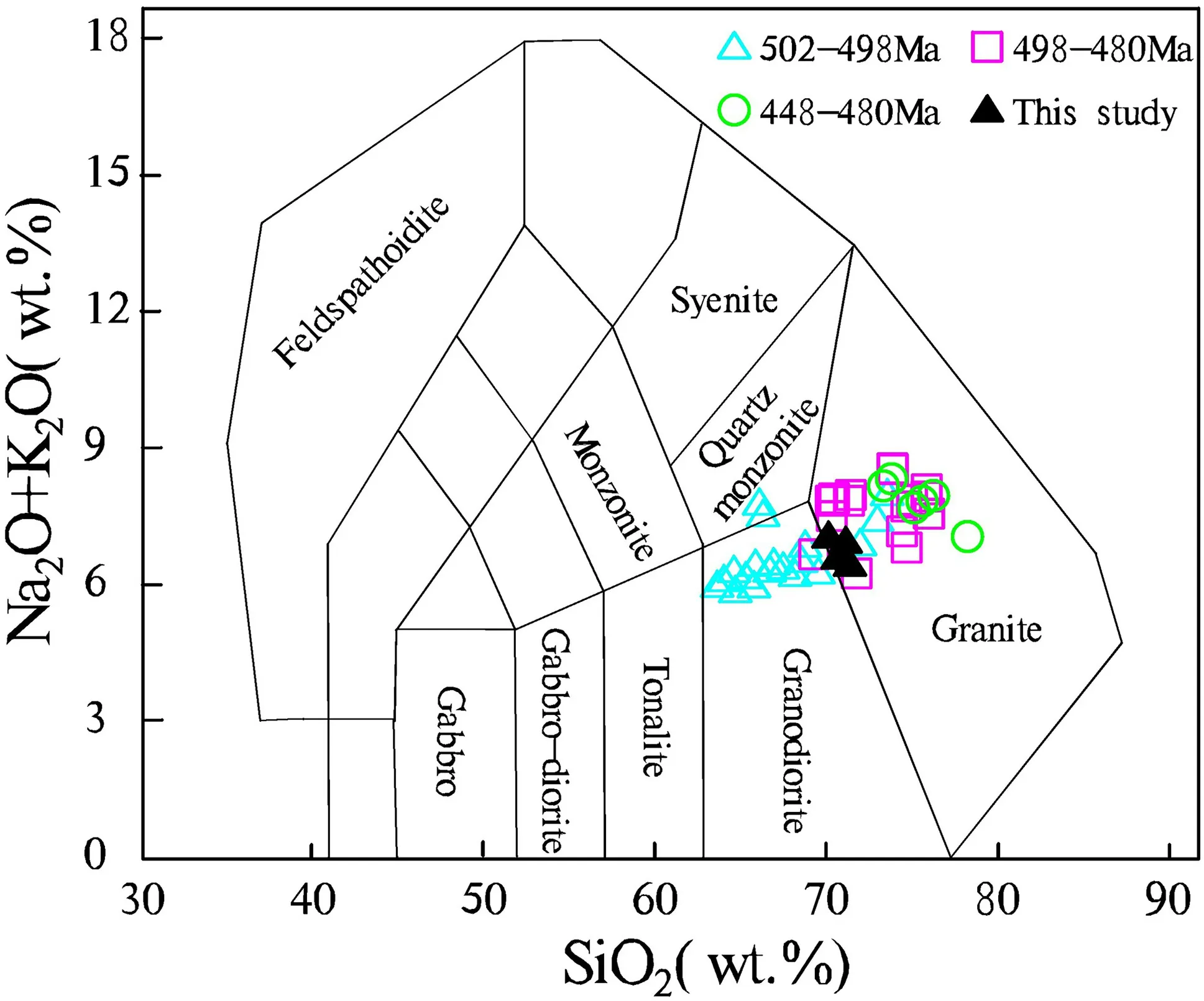
Fig.3 The TAS classification diagram of the Early Paleozoic granites in the Baoshan block,SW China (Middlemost 1994).Previous data on the Pinghe granites are from Liu et al.(2009) and Dong et al.(2012,2013b)

Fig.4 Modified alkali-line index (Na2O+K2O–CaO) versus SiO2 diagram of the Early Paleozoic granites in the Baoshan block,SW China (Frost et al.2001),Symbols are the same as those in Fig.3
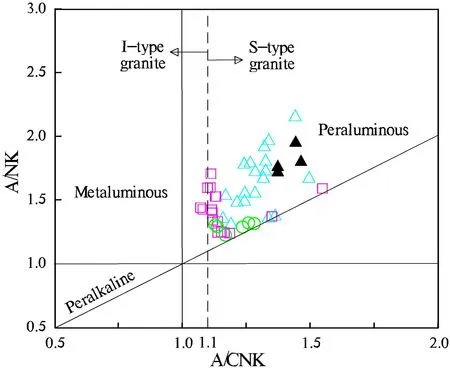
Fig.5 Molar Al/(Na+K) vs.Al/(Ca+Na+K) diagram of the Early Paleozoic granites in the Baoshan block,SW China(Maniar and Piccoli 1989).Symbols are the same as those in Fig.3
Figure 6a shows chondrite-normalized REE patterns and a spider diagram of the samples.Similar patterns can be seen in the chondrite normalized REE patterns of the four different rock types,which show enriched LREE and relatively depleted HREE.Their Eu anomalies are likewise roughly the same,with δEu [δEu=EuN/(SmN× GdN)1/2]between 0.47 and 0.69.REE content ranges from 136.15 to 148.42 ppm.The LREE/HREE values are between 4.63 and 5.47.All of the samples exhibit negative anomalies of Ba,Nb,Sr,and,to a lesser extent,Hf in the primitivemantle-normalized trace element patterns (Fig.6b).
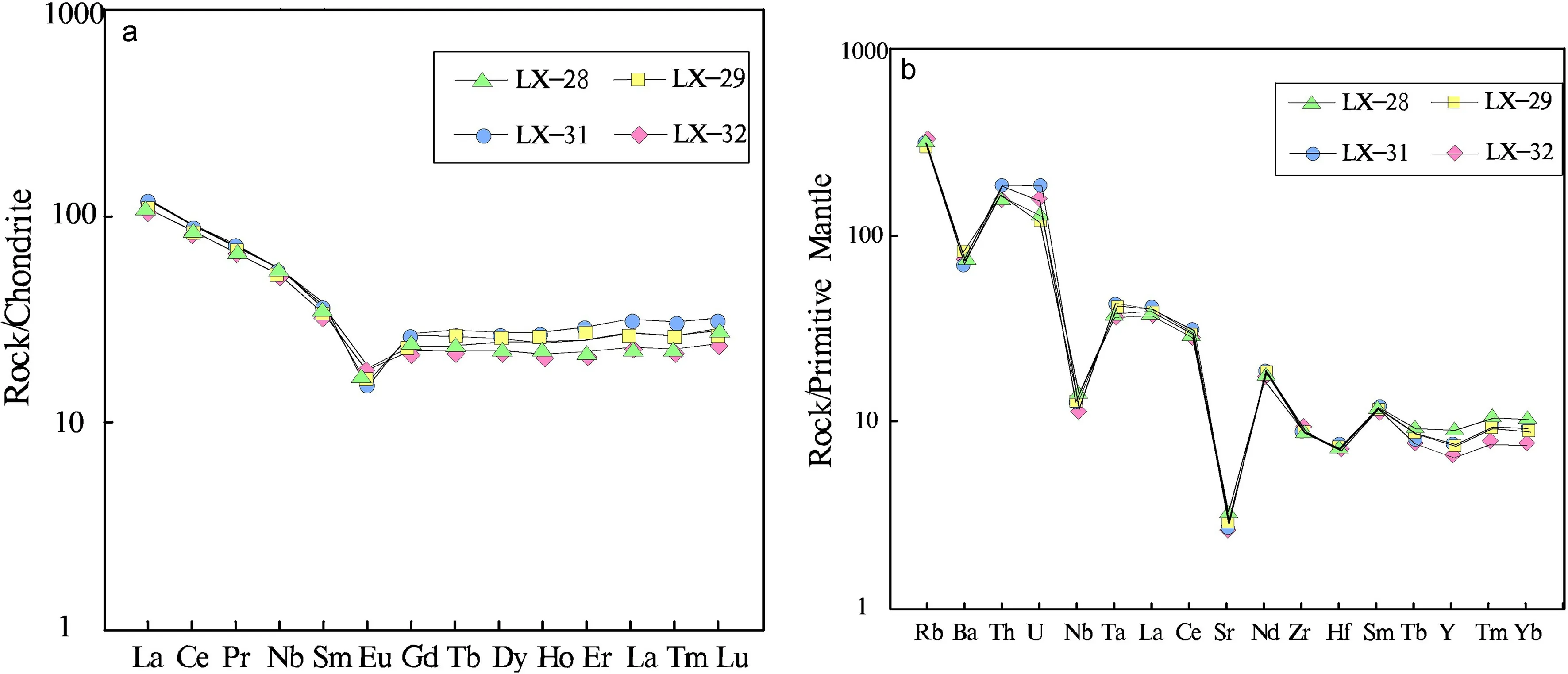
Fig.6 a Primitive mantle-normalized trace element spidergram and b chondrite-normalized REE patterns of the Nansa granites in the Baoshan block,SW China (Sun and McDonough 1989)
4.2 Zircon U–Pb age
The zircon grains in sample LX-27 are mostly subhedral to euhedral,with prismatic shapes (80–200 m long) and an aspect ratio of 1:1–4:1.In CL pictures,they are translucent,colorless to pale brown,and show evident magmatic oscillatory zoning (Fig.7).Twenty-five analytical spots from LX-27 yielded a wide range of uranium(183–1535 ppm)and thorium(70–356 ppm)contents,with Th/U ratios ranging from 0.2 to 0.6 (Table 2),indicating a magmatic origin (Hoskin and Schaltegger 2018).Twentyfive examinations of these sites resulted in a weighted mean206Pb/238U age of 480.1 ± 4.4 Ma (MSWD=0.63,Fig.8),which we interpreted as the granite’s crystallization age.
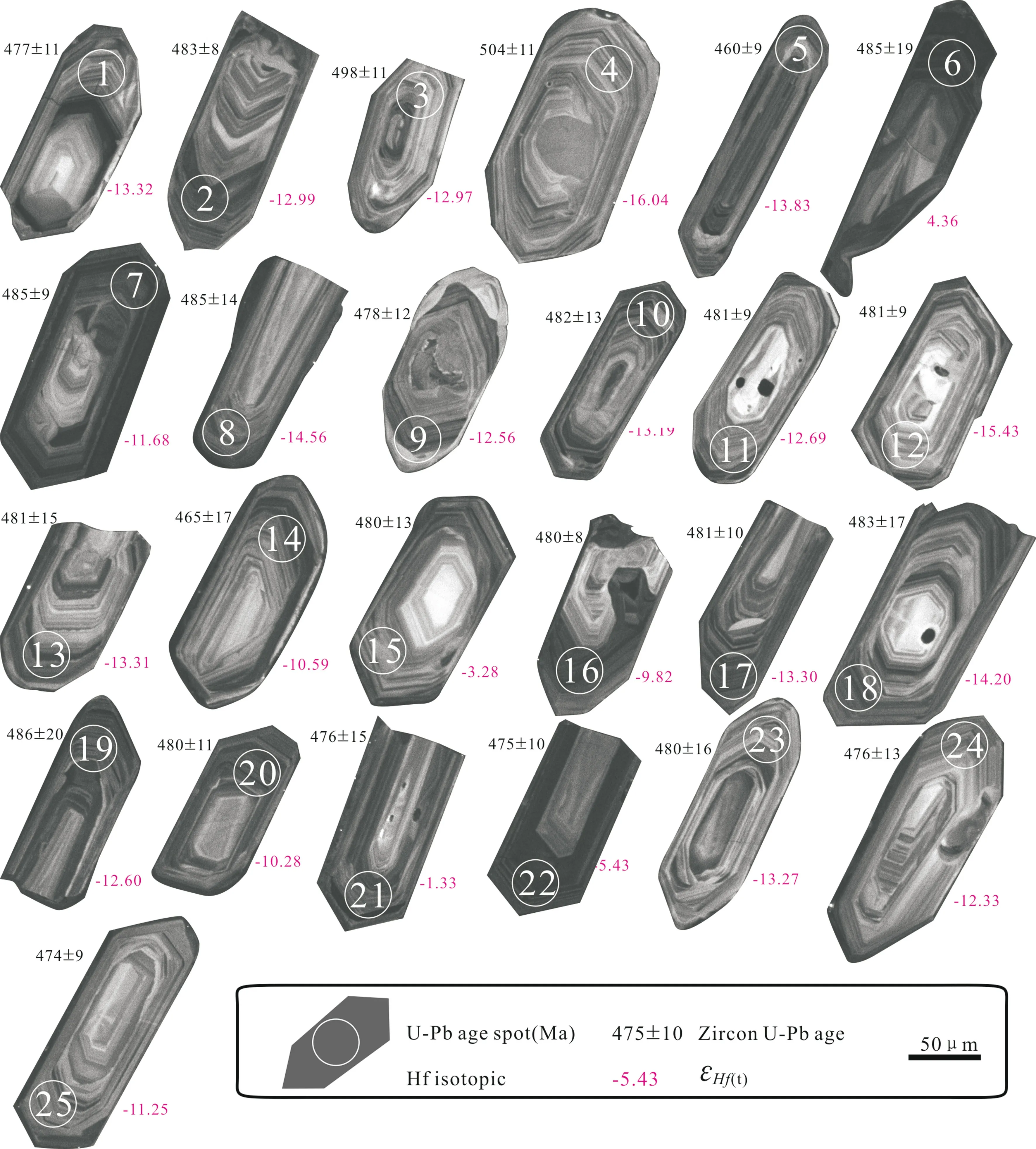
Fig.7 Cathodoluminescence (CL)electron micrographs of representative zircons separated from the Nansa granites in the Baoshan block,SW China.Spots are analyses of in-situ U–Pb and Hf isotopes
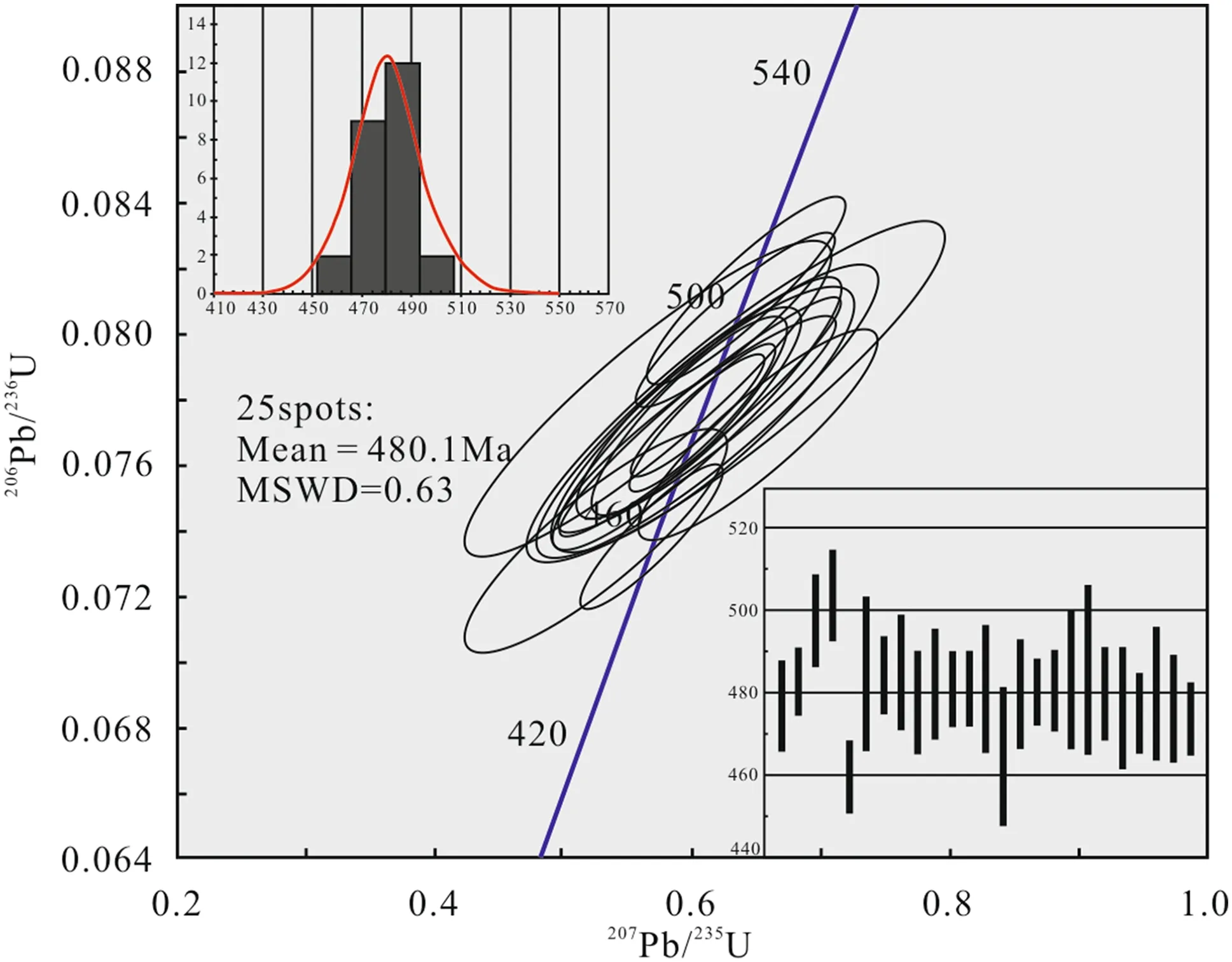
Fig.8 Concordia diagrams of zircon U–Pb data of representative zircons separated from the Nansa granites in the Baoshan block,SW China
4.3 Zircon Hf isotopes
Table 3 shows the determined values for zircon Hf isotopes.Twenty-five spot studies for zircon from sample LX-27 revealed176Lu/177Hf and176Hf/177Hf ratios of 0.000977–0.004325 and 0.282318–0.282895,respectively,showing that176Hf has low radiogenic growth.They have fLu/Hfratios ranging from -0.97 to -0.87,with a concentration between -0.96 and -0.95,which is significantly lower than the mafic crust (-0.34) (Amelin et al.2000) and sialic crust (-0.72) (Vervoort and Patchett 1996).TCDMages range from 0.81 to 2.10 Ga,with the majority of them falling between 1.71 and 1.98 Ga.The computed εHf(t) values range from -16.04 to -1.33,with one exception of 4.36.The εHf(t)values of these Early Paleozoic granites in this study are within those of the already reported ca.500 to 450 Ma peraluminous granites in the Baoshan block (Chen et al.2008;Liu et al.2009;Dong et al.2012,2013b;Wang et al.2013).Inherited and xenocrystic zircons in the granites from the Shuangmaidi and Mengmao areas in the Baoshan block with206Pb/238U ages of ca.540 to 480 Ma have much varied εHf(t) values from -11.1 to+13.5.Other older (>550 Ma) inherited cores and xenocrysts show varied εHf(t) values and TCDMages (Dong et al.2012).For instance,the Neoproterozoic(955–565 Ma) inherited grains mainly display positive εHf(t) values of 0.3 to 9.5 with TCDMages of 1645 to 1150 Ma (Li et al.2016a).Overall,the Hf isotopic results for zircon from the granitic batholith show that it originated from the Paleo-Mesoproterozoic crust.
5 Discussion
5.1 Early Paleozoic magmatism
The two-mica granites from Zhibenshan and the peraluminous granites from the Shuangmaidi were deposited to the north of the Baoshan block at around 473 and 470–459 Ma,respectively (Chen 1987).The Mengmao granites in the center of the Baoshan block have been dated to between 480 and 455 Ma (Xiong et al.2012).Leucogranite from the Pinghe Formation and monzogranite from the same batholiths were both deposited to the south of the Baoshan block at approximately 476–448 and 502–466 Ma,respectively (Liu et al.2009;Dong et al.2013b;Wang et al.2013).According to the geochronological evidence presented here,the Nansa granitics were produced around 480 Ma.These findings show that the Baoshan block experienced Early Paleozoic magmatism between 502 and 448 Ma.Some continental blocks also include Early Paleozoic magmatism.The Tengchong block’s granitic gneiss has produced zircon U–Pb ages of approximately 456 Ma (Cong et al.2010) and approximately 518–484 Ma(Li et al.2011;Cai et al.2013).In the Sibumasu block of the Upper Peninsula of Thailand,the Khao Tao orthogneiss formed around 502 Ma (Lin et al.2013) and the Khao Dat Fa granite formed in 477 Ma(Kawakami et al.2014).Zircon U–Pb dating in the Western Qiangtang (476–471 Ma) (Pullen et al.2011),Amdo(530–470 Ma)(Jerome et al.2012),and Tethyan Himalaya(530–470 Ma) (Cawood and Buchan 2007;Quigley et al.2008) have also revealed the presence of Early Paleozoic magmatic rocks.The current research on tectonomagmatic records suggests that these blocks,together with the Baoshan block,were all oriented along the proto-Tethyan border of East Gondwana in the Early Paleozoic(Metcalfe 2006,2013),implying that Early Paleozoic magmatism was substantially developed along the peri-Gondwana frontier.
5.2 Petrogenesis
5.2.1 Petrogenetic type Chappell and White (1974,1992) proposed the S-I classification for granites,which later evolved into the‘‘alphabet classification’’ of S-,I-,M-,and A-type granites.The samples differ from M-type granites,which typically have K2O contents of less than 1 wt.%,by having high K2O contents of 3.79–4.18 wt.% (Bonin 2007).The SiO2contents of 69.80–71.15 wt.%,A/CNK ratios of 1.37–1.46,and normative-CIPW corundum contents of 4.73–5.75 wt.% of the Nansa granitic rocks are similar to S-type granites other than A-and I-type granites (Clemens 2003).For the following two reasons,we rule out the likelihood that they are A-type: In all the granites we have evaluated,hereditary zircon cores are prevalent(Fig.7),but they are uncommon in A-type granites (Li et al.2010b);in addition,they all have low (Na2O+K2O)/CaO ratios (4.04–5.82),FeOT/MgO ratios (1.75–2.41),and HFSE contents (Zr+Nb +Ce+Y=198.08–205.11 ppm) (Whalen et al.1987;Eby 1990)(Fig.9a–c).They are less likely to be I-type granites,which are predominantly metaluminous with A/CNK ratios typically <1.1 (Bruce et al.2012).These samples are classified as S-type granites on the(Al2O3-(K2O+Na2O)-CaO-(FeOT+MgO) discrimination diagrams (Fig.9d).

Fig.9 Geochemical data for the Early Paleozoic granites in the Baoshan block,SW China,plotted on a the FeOT/MgO vs.SiO2 diagram(Eby 1990),b the FeOT/MgO vs.Zr+Nb+Ce+Y diagram (Whalen et al.1987),c the (Na2O+K2O)/CaO vs.Zr+Nb+Ce+Y diagram(Whalen et al.1987),and d the [Al2O3–(K2O+Na2O)]–CaO–(FeOT+MgO) diagram(Chappell and White 1974).Symbols are the same as those in Fig.3
5.3 Fractional crystallization

The spidergrams show substantially negative Ba,Sr,Eu,P,Nb,and Ti anomalies as well as a decrease in MgO and Fe2O3,indicating that advanced fractional crystallization was active during the magmatic evolution (Table 2;Fig.8a,b).MgO and FeOTlevels dropping during magmatic evolution suggest that ferromagnesian minerals (biotite and hornblende)were separated during crystallization.Substantial Ba,Sr,and Eu depletion necessitates significant plagioclase and/or K-feldspar fractionation (Wu et al.2003;Li et al.2015b).The strong positive association between Sr and Ba and Eu/Eu* and the weak negative correlation between Sr and Rb support the significant removal of plagioclase and K-feldspar (Fig.10a–c).The fractionation of apatite produced the significant negative P anomaly (Zhang et al.2019).The negative Nb and Ti anomalies were attributed to fractionation of the Ti-bearing phase(e.g.,ilmenite)(Liu et al.2018).Accessory minerals have primarily regulated the REE distribution.Further support for the fractionation of apatite,which preferentially incorporates medium REE from the remaining silicate melt,can be provided by the Nansa granites’low(Gd/Yb)Ncontent (0.61–0.71) (Prowatke and Klemme 2006).The graph of(La/Yb)Nvs.La(Fig.10d)and the drop in REE in all samples support the considerable elimination of monazite (less than 1%) and allanite.

Fig.10 Sr versus Ba (a),Sr versus Rb (b),Eu*/Eu versus Sr (c)and (La/Yb)N vs.La diagrams for the Early Paleozoic granites in the Baoshan block,SW China.Kf,Pl,Bi and Hb note the removal of K-feldspar,plagioclase,biotite and hornblende during magma evolution,respectively(Wang et al.2013).Symbols are the same as those in Fig.3
5.3.1 Nature of source rocks
Typically,the petrogenesis of peraluminous granites is illustrated by fractionation of aluminous-poor magma or derivation from crustal rocks with metapelite and metaigneous components (Clemens 2003).Upper crust granites frequently have low Eu/Eu* ratios (<1.0),high Th (>10 ppm),Pb (>20 ppm),and U (>2 ppm).The Nansa granites have atypically high Th (13.23–15.82 ppm),Pb(29.88–41.29 ppm),and U(2.47–3.92 ppm),as well as low Eu/Eu* ratios (0.47–0.69),which shows that the source rocks of the granite were derived from the upper crustal materials.These anomalously high Th,Pb,and U values contrast with the general characteristics of the granite researched by Rudnick and Fountain (1995).
According to experiments,extremely peraluminous granites formed from pelitic rocks with a high clay content and little plagioclase have a CaO/Na2O ratio(<0.3)that is much lower than that of meta-igneous rocks and psammitic rocks with a high plagioclase content and a CaO/Na2O ratio (>0.3).The samples show a preference for psammite-derived melt because of their high CaO/Na2O ratios of 0.42–0.70 and low Al2O3/TiO2ratios of 72.82–84.55(Fig.11a).The Rb–Sr-Ba variations in exceedingly peraluminous granites have been used to decipher source properties (Sylvester 1998).The Nansa granites are at the melt endmember derived from psammite and have low Rb/Sr and Rb/Ba ratios,which are within the ranges for claypoor sources (Fig.11b).
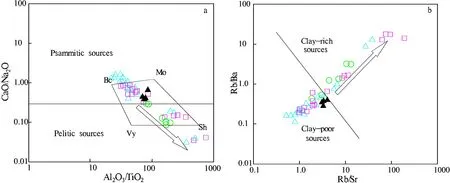
Fig.11 a CaO/Na2O vs.Al2O3/TiO2 and Rb/Ba vs.Rb/Sr diagrams of the Early Paleozoic granites in the Baoshan block,SW China(Sylvester 1998).Be-Bethanga intrusion in Lachlan fold belt,Australia;Mo-Moschumandl intrusion in Alps oronenic belt;Vy-Vysoky-Kamen intrusion in Hercynian orogenic belt;Sh-Shisga Pangma intrusion in Himalaya orogenic belt.Symbols are the same as those in Fig.3
The Hf isotope of zircon in magmatic rocks has been successfully used for source rock tracking.In general,juvenile crustal material formed by differentiation of mantle material and mantle-derived rocks have high εHf(-t)values and176Hf/177Hf ratios in zircons,whereas crust or crust-contaminated zircons have lower εHf(t) values and176Hf/177Hf ratios (Kinny 2003;Shen et al.2009).Except for one outlier of 4.36,the εHf(t) values of the samples range from -16.04 to -1.33 and are somewhat higher than those of the S-type granitoids,which were assumed to arise almost exclusively from crustal basement in the Baoshan block (Dong et al.2013b) and point near the chondrite evolution line and the lower crust region(Fig.12),suggesting that the source magma of the Nansa granites were generated from the ancient crust with minimal mantle melts being added.Zircons’ εHf(t) values of 4.36 give some indication of the contributions made by melts coming from the mantle(Li et al.2016b).The TCDMdates of the rocks range from 0.81 to 2.10 Ga,indicating that the ancient crust originated during the Paleo-Mesoproterozoic period.

Fig.12 Plots of εHf(t) vs.U–Pb ages of the Nansa granites in the Baoshan block,SW China
5.4 Tectonic implications
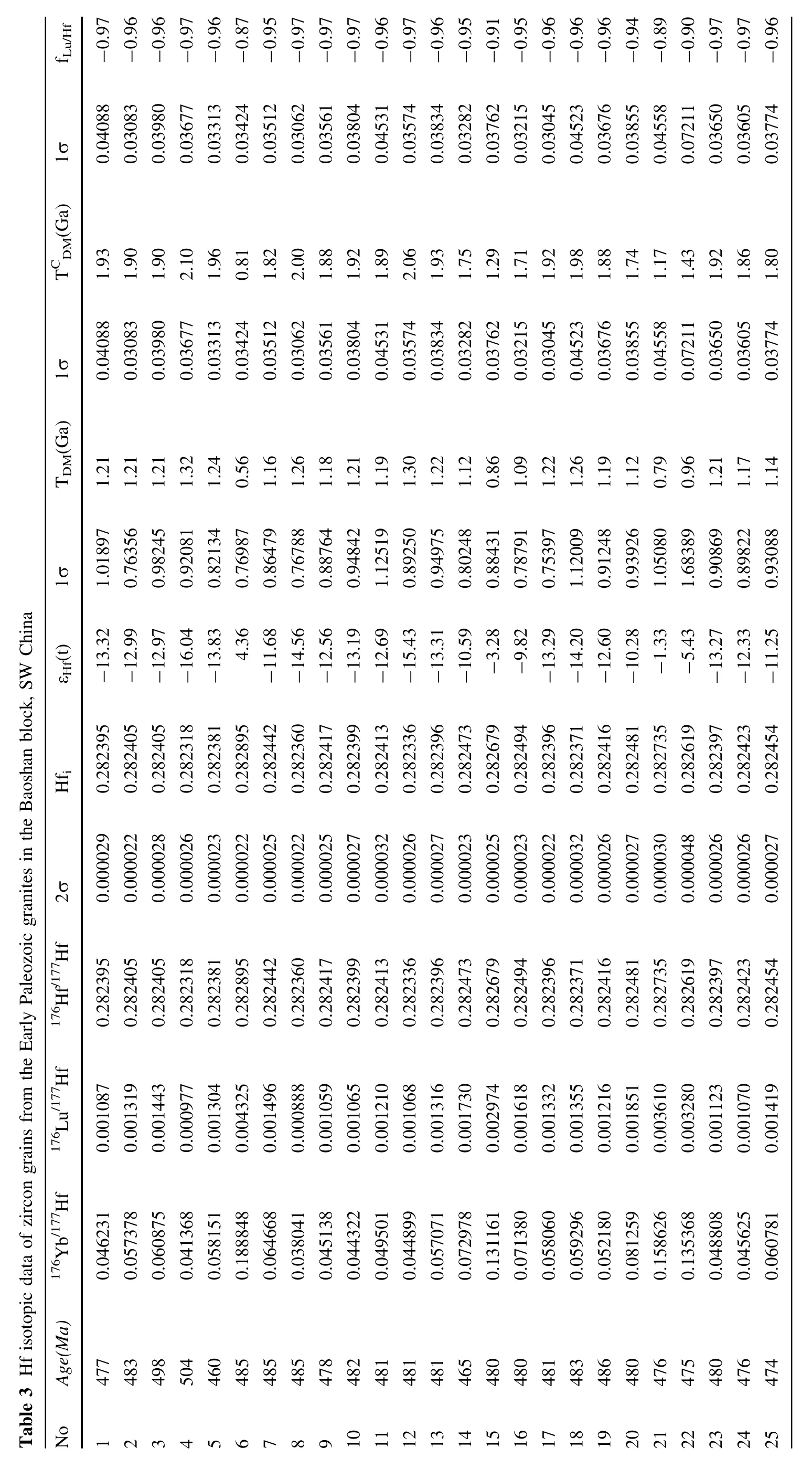
5.4.1 Tectonic significance Flat HREE patterns (GdN/YbN=0.61–0.71) and high Y(30.64–41.00 ppm) and Yb (Yb=3.89–5.18 ppm) contents show that the samples lack residual garnet,which persists at pressures of 0.5 GPa (Wang et al.2012).The samples on the (Al2O3+Fe2O3T+MgO+Ti2O) versus Al2O3/(Fe2O3T+MgO+Ti2O) diagram (Fig.13a) were made experimentally at pressures plotted within the LP reaction field that corresponded to pressures less than 5 kbar (Douce 1999).Granitic melts that are hotter(>875 °C) have low Al2O3/TiO2ratios of less than 100,whereas melts that are cooler(<875 °C)have high Al2O3/TiO2ratios of more than 100(Sylvester 1998).The average Al2O3/TiO2ratio of the granites is 78,indicating that the magma temperature was higher than 875 °C.In the Pb vs.Ba diagram,the samples are plotted in the high temperature field (Fig.13b).As a result,magma should have been created in an extensional tectonic setting of high temperature and low pressure (HTLP).Experimental simulation investigations have demonstrated that the heat required to partially melt the metasedimentary rocks at this temperature range under normal geothermal gradients is certainly insufficient at crust depths of 16.5 km (Sylvester 1998;Clemens 2003).As was previously indicated,the slight mantle melts are likely what provided the extra heat for crustal anatexis in the peraluminous granites from the Nansa area,which were produced mostly from partial melting of old metasedimentary rocks.

Fig.13 Diagrams showing P–T conditions of magma generation in the Baoshan block,SW China.a Ba versus Pb (Finger and Schiller 2012);b [Al2O3/(Fe2O3T+MgO+TiO2)] versus (Al2O3+Fe2O3T+MgO+TiO2),and melts produced by experiments during different pressure conditions(Douce 1999).The thick solid lines represent the reaction curves: HP (P=12–15 kbar) and LP (P ≤5 kbar).Abbreviations: Bt,biotite;F,weight fraction of melt relative to original parent;HT,high temperature;LT,low temperature;MS,muscovite;LP,low pressure.Symbols are the same as those in Fig.3
Many tectonic scenarios have been presented,including East Gondwana’s final assembly (Meert and Voo 1997),crustal extension in a non-arc environment (Miller et al.2001;Collins et al.2014),and an Andean-type orogeny(Cawood et al.2007).The Nb vs.Y and Rb vs.Y+Nb graphs (Figs.14a and b) show that the Nansa granites fall within the fields of volcanic arc granite and syn-collisional granite,indicating that arc-related magmatism most likely existed in the Baoshan block in the Early Paleozoic.Moreover,these granites’ geochemical traits reflect those of leucogranites that were deposited in collisional orogens elsewhere,including in the high Himalaya,which reduces the likelihood of crustal extension in non-arc environments(Guo and Wilson 2012;Wang et al.2012).The Himalayan orogen,which includes NW India,the southern Tibetan Plateau,and central Nepal’s Himalaya,has all been linked to Cambro-Ordovician deformation and metamorphism(Argles et al.1999).In the Lhasa (Chen et al.2022),Tethyan Himalaya (Garzanti et al.1986),and Baoshan(Dong 2016) blocks,Cambro-Ordovician angular unconformity was extensively developed.Furthermore,the bulk of Early Paleozoic magmatic rocks were deposited within peri-Gondwanan continental blocks at a time that was far later than the final assembly of Gondwana (ca.570–520 Ma),hence eliminating the likelihood of Gondwana’s final assembly (Meert 2003;Cawood et al.2007).In conclusion,the evidence implies that the Early Palaeozoic S-type granites in the Baoshan block were formed in an HTLP extensional tectonic context as a result of Andean-type orogeny rather than in the final assembly of Gondwana or in crustal extension in a non-arc environment.
5.4.2 Tectonic model
The tectonic contexts in which the peraluminous granites may have developed include continental arcs,back-arcs,syncollisional environments,and post-collisional environments(Collins and Richards 2008;Li et al.2016a).Earlier research revealed that proto-Tethyan slab rollback(>500 Ma),slab breakoff (ca.500–490 Ma),lithospheric thickening (ca.490–475 Ma),and lithospheric delamination (ca.475–460 Ma) were the causes of the long-lasting Early Paleozoic peraluminous magmatism in the Baoshan block (Zhu et al.2012,2013;Dong et al.2013a;Li et al.2016a).Around 450 Ma marked the end of proto-Tethyan accretionary orogenesis,when magmatism ceased to occur(Li et al.2016a).According to the aforementioned study,the Nansa granites were created in an extensional tectonic setting of high temperature and low pressure (HTLP),in contradiction to previous analyses.For a deeper description of their tectonic setting,the regional geology must be taken into account.
Prior researches has described a phase of Early Paleozoic magmatism in the Baoshan block that lasted in two distinct periods,502–486 and 476–448 Ma (Dong et al.2013a,b).Both phases had asthenosphere material upwelling,and phases I and II correlate to the proto-Tethyan oceanic slab breakoff and the lithospheric delamination,respectively(Hu et al.2015).During the two eras of magmatism,the tectonic setting thickened and shortened,and there was almost no upwelling of mantle material or granite,which was consistent with the absence of Early Ordovician strata (ca.490–470 Ma) and the existence of Late Ordovician strata in the Baoshan block(Cai et al.2013).Given the facts presented above,this article also recognizes that the lithospheric thickening occurred between 490 and 475 Ma,causing the volcanosedimentary sequence of the Gongyanghe Group to fold(Zhu et al.2012;Li et al.2016a)and the local formation of peraluminous igneous rocks (such as this article) in the Baoshan block.In contrast to the tectonic background of the lithosphere’s thickening and shortening,this research postulates that an expanding environment may exist in certain localities,causing the crust to melt and decompress,mantle-derived elements to mix,and a small amount of peraluminous granite to developed (Fig.15).Seldom occurring peraluminous granite of this type corresponds to the paucity of intrusive rocks between 490 and 470 Ma.

Fig.15 Schematic illustrations showing the petrogenesis and tectonic setting for the late Cambrian to Early Ordovician magmatism along the East Gondwana margin (Zhao et al.2017)
Following the accretion of the outer block,the slab breakoff of the subducting proto-Tethyan oceanic lithosphere occurred at 499–492 Ma (Fig.15a).The slab breakoff caused partial melting of the overlaying lithosphere mantle wedge,resulting in parental basaltic melts for the ca.499 Ma metabasalts in the Gongyanghe Group’s uppermost section.Such mantle-derived magmas could have also contributed heat and possibly material for crustal anatexis,resulting in the formation of enormous peraluminous granites like the main body of the Pinghe pluton(Thibault et al.2011;Zhu et al.2012).At roughly 492–475 Ma,the lithospheric thickening occurred,producing the folding of the Gongyanghe Group’s volcanosedimentary sequence and the local formation of peraluminous granitic rocks in the crust,such as the Nansa granite (Fig.15b) (Von Blanckenburg and Davies 1995;Dong et al.2013b;Zhao et al.2017).The long-lived Cambrian-Ordovician peraluminous granitic magmatism in the Baoshan block was formed according to hypothesized sequential tectonic models;however,these models need more support from geological,geochronological,and geochemical research on the Early Paleozoic geological records.
6 Conclusions
The Nansa intrusion in the Baoshan block was emplaced during the Early Ordovician at ca.480 Ma,and the intrusive rocks are high-K,calc-alkaline,strongly peraluminous granites with almost crustal isotopic characteristics.The Early Ordovician granitic magma in the Baoshan block experienced crystallization fractionation and could be derived from the partial melting of metagreywacke with minor mantle melts.
The Early Palaeozoic S-type granites from Nansa area were generated in a high-temperature and low-pressure(HTLP) extensional tectonic setting,which resulted from Andean-type orogeny instead of the final assembly of Gondwana or crustal extension in a non-arc environment.
In certain places,an expanding environment may exist in opposition to the tectonic backdrop of the lithosphere’s thickening and shortening,leading the crust to melt and decompress,mantle-derived materials to mix,and a small quantity of peraluminous granite to emerge.
Authors’ contributionsJ-JZ conceived of the presented idea and developed the theoretical formalism after wrote the manuscript.C-DL provision of samples and preparation of regional geological maps.YZ,TC and H-LL helped complete sample processing and testing.C-LM contributed to the final version of the manuscript.
FundingThis research is funded by the National Natural Science Foundation of China (2019M653840XB) and the National Natural Science Foundation of China (41972043 and 42062006).
Availability of data and materialThe results from our study is our original unpublished work and it has not been submitted to any other journal for reviews.
Code availabilityThere are no software application or custom code.
Declarations
Conflict of interestOn behalf of all authors,the corresponding author states that there is no conflict of interest.
Ethics approvalThis manuscript we wish to be considered for publication in ‘‘ACTA Geochimica’’.No conflict of interest exits in the submission of this manuscript,and manuscript is approved by all authors for publication.I would like to declare on behalf of my coauthors that the work described was original research that has not been published previously,and not under consideration for publication elsewhere,in whole or in part.All the authors listed have approved the manuscript that is enclosed.
杂志排行
Acta Geochimica的其它文章
- Geochemistry and mineral chemistry of the armoor granitoids,eastern dharwar craton: implications for the redox conditions and tectono-magmatic environment
- The late Early-Paleozoic granitic magmatism in Northwestern Fujian,China: constraints on intraplate orogeny in the South China block
- Mineralogy and geochemistry of trachytic rocks from the Lichi Volcanics,Eastern Himalaya: insights into the Kerguelen mantle plume activity in the Eastern Himalayan Region
- Solute transport and geochemical modeling of the coastal quaternary aquifer,Delta Dahab Basin,South Sinai,Egypt
- Distribution,health and ecological risk assessments of trace elements in Nigerian oil sands
- Petrogenesis and tectonic implications of the Silurian adakitic granitoids in the eastern segment of the Qilian Orogenic Belt,Northwest China
